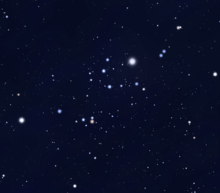- Alpha Persei Cluster
-
Alpha Persei Cluster 
Observation data (2000.0 epoch) Constellation Perseus Right ascension 03h 26.9m Declination +49° 07′ Distance 557-650 ly[1][2][3] (171-200 pc) Apparent magnitude (V) 1.2 Apparent dimensions (V) 185' Physical characteristics Other designations Cr 39, Mel 20 See also: Open cluster, List of open clusters The Alpha Persei Cluster, also known as Melotte 20 or Collinder 39, is an open cluster in the constellation of Perseus. To the naked eye, the cluster consists of several blue spectral type B type stars. The most luminous member is the ~2nd magnitude white-yellow supergiant Mirfak, also known as Alpha Persei. Bright members also include Delta, Epsilon, Psi, 29, 30, 34 and 48 Persei. The Hipparcos satellite and infrared color-magnitude diagram fitting have been used to establish a distance to the cluster of ~172 pc.[2][3] The distance established via the independent analyses agree, thereby making the cluster an important rung on the cosmic distance ladder. The age of this cluster is about 50-70 million years.[1][4]
Members
Designations Spectral type
&
Luminosity classComments α Per (33 Per) F5Ib δ Per (39 Per) B5III ε Per (45 Per) B1V ψ Per 29 Per 30 Per 34 Per 48 Per References
- ^ a b Prosser, Charles F.; Randich, Sofia; Stauffer, Joh R.; Schmitt, J. H. M. M.; Simon, Theodore (October 1996). "ROSAT Pointed Observations of the Alpha Persei Cluster". Astronomical Journal 112: 1570. Bibcode 1996AJ....112.1570P. doi:10.1086/118124.
- ^ a b van Leeuwen, F. "Parallaxes and proper motions for 20 open clusters as based on the new Hipparcos catalogue", A&A, 2009
- ^ a b Majaess, D.; Turner, D.; Lane, D.; Krajci, T. "Deep Infrared ZAMS Fits to Benchmark Open Clusters Hosting delta Scuti Stars", JAAVSO, 2011
- ^ Paunzen, E., Mermilliod, J.-C. "WEBDA: Alpha Persei"
External links
Categories:- Open clusters
- Perseus constellation
- Star cluster stubs
Wikimedia Foundation. 2010.
